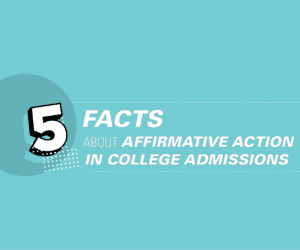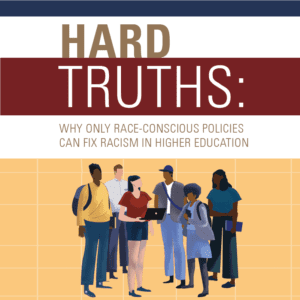
Affirmative action has historically been an instrument that colleges can use to ensure that students of color receive fair consideration for admissions given the systemic barriers, underinvestment in schools that students of color attend, inequities in access to advanced coursework, and non-academic factors that overwhelmingly advantage White and wealthier applicants.
Affirmative action has also been a longstanding topic of debate. A Supreme Court decision may put an end to considering race in college admissions. But research shows that most Americans continue to support affirmative action to counteract the effects of discrimination and create pathways for all students to thrive. No Supreme Court decision will change that.
This section takes a deep dive into all the aspects of affirmative action and serves to both level-set the conversation and move it forward. In this blog series, we partner with national experts, scholars, advocates, and practitioners to delve into four key areas: the historical context of affirmative action, changes in admissions policies and practices needed to advance equity, benefits of removing barriers for focus populations, and policy alternatives that pave the way for a more diverse campus environment.
There’s more progress needed to create a fairer and more inclusive future. Colleges and universities must not retreat from their commitment to equity. The Education Trust will not retreat from providing policy recommendations, advocacy and other resources to students and higher education leaders to ensure the inequitable barriers students of color face in college admissions are eliminated.
Blog Series
A Brief History of Affirmative Action and the Assault on Race-Conscious Admissions

As we await the U.S. Supreme Court’s ruling on Students for Fair Admissions v. Harvard College and Students for Fair Admission v. University of North Carolina challenging the use of affirmative action and race-conscious college admissions, it’s important to consider what led to this point. This piece offers a brief history of affirmative action as well as of the major court cases seeking to end its use.
Two Cautions for Educators to Consider in the Aftermath of Affirmative Action Decisions

As influential as the U.S. Supreme Court’s forthcoming decisions on affirmative action will be, it’s important to remember that court opinions do not implement themselves — all educators in our various professional roles give them meaning, and the meaning will have consequences for our multiracial democracy.
Without Affirmative Action, It’s Back to Basics

This spring, the US Supreme Court is widely expected to ban the consideration of race in college admissions, ending a practice that—while well-intentioned—never actually succeeded in ensuring that racial demographics at the nation’s selective colleges came close to resembling those of the college-aged population.
Segregation Forever: Private Universities Haven’t Leveraged Race-Conscious Admissions to Increase Diversity. What Now?

As we await the Supreme Court’s decisions in Students for Fair Admissions v. Harvard College and Students for Fair Admission v. University of North Carolina on the use of race-conscious practices in college admissions, we must acknowledge that selective public institutions and selective private institutions don’t reflect the diversity of states and the nation more broadly, even with affirmative action as a factor in admissions.
Navigating College and Beyond Without Affirmative Action

The need for diversity, equity and access in college admissions, across university campuses and in the workforce — couldn’t be more heightened. Today, America stands at a crossroads of fighting to preserve and protect our democracy, maintain our values, and stand firm in the gains of the Civil Rights Movement while fighting against white supremacy and the ghost of Jim Crow. This battle got more difficult in June, when the Supreme Court ruled to do away with affirmative action.
Colleges and Universities Must Commit to Student Belonging in Light of Affirmative Action Rulings and Attacks on DEI
 The SCOTUS decisions have had a chilling effect in the field of higher education, with institutions often overextending the interpretation of the Court’s ruling. This overextension stems from fear that a school’s program or initiative might result in the loss of funding, calls for administrator or faculty resignation, or the next high-profile and costly lawsuit.
The SCOTUS decisions have had a chilling effect in the field of higher education, with institutions often overextending the interpretation of the Court’s ruling. This overextension stems from fear that a school’s program or initiative might result in the loss of funding, calls for administrator or faculty resignation, or the next high-profile and costly lawsuit.
In a Post-Affirmative Action World, Colleges Can Help Foster Diversity By Banning the Box on College Applications
 As U.S. colleges and universities grapple with declining enrollments and attacks on race-conscious admissions, banning the box is one way for institutions to open their doors to the nearly 70 million Americans facing barriers to college access due to a history with the legal system.
As U.S. colleges and universities grapple with declining enrollments and attacks on race-conscious admissions, banning the box is one way for institutions to open their doors to the nearly 70 million Americans facing barriers to college access due to a history with the legal system.
To Dismantle Structural Racism in College Recruiting, Policymakers and Advocates Must Play Offense, Not Defense
 Following the Supreme Court decision to ban race-conscious admissions, which tools can be used to uphold our commitment to racial justice in college access? Many higher education leaders have highlighted the importance of identifying and recruiting prospective students earlier on, since the Court’s decision applies to admissions decisions.
Following the Supreme Court decision to ban race-conscious admissions, which tools can be used to uphold our commitment to racial justice in college access? Many higher education leaders have highlighted the importance of identifying and recruiting prospective students earlier on, since the Court’s decision applies to admissions decisions.
How Colleges Can Better Support Undocumented Students in the Aftermath of the Affirmative Action Ban
 Racial inequity is baked into the higher education system, but the Supreme Court’s decision to ban affirmative action means colleges can no longer consider race as one of many factors when evaluating a student’s potential admission. Many worry that racial diversity on college campuses will plummet, as it has in states like California and Michigan that banned race-conscious admissions.
Racial inequity is baked into the higher education system, but the Supreme Court’s decision to ban affirmative action means colleges can no longer consider race as one of many factors when evaluating a student’s potential admission. Many worry that racial diversity on college campuses will plummet, as it has in states like California and Michigan that banned race-conscious admissions.
Promoting Racial Equity Through Federal-State College Affordability Partnerships
 Concerns over college affordability have mounted in recent decades with generally declining levels of state support for public colleges, rising tuition levels (partly in response to declining state support), and federal and state financial aid investments that are insufficient to offset rising tuition. These trends are particularly concerning as our society grows more diverse and multicultural.
Concerns over college affordability have mounted in recent decades with generally declining levels of state support for public colleges, rising tuition levels (partly in response to declining state support), and federal and state financial aid investments that are insufficient to offset rising tuition. These trends are particularly concerning as our society grows more diverse and multicultural.
Infographics
INFOGRAPHIC: 5 Facts About Affirmative Action

Like it or not, the hard truth is that America has a long history of discrimination against people of color and women, who have systemically been denied access to voting rights, housing, economic development, education access, and more. Unfairness and inequality was the impetus of the Civil Rights Movement, and out of that era came some of the strongest equity-focused legislation and tools meant to address these pervasive inequities.
One of those tools is affirmative action, a set of policies that was designed to eliminate unlawful racial, religious, and gender discrimination among applicants in employment and education that has been in place since 1965.
INFOGRAPHIC: The Nepo Babies of Higher Ed

College admissions have never been a level playing field. But, contrary to the current political rhetoric, when it comes to which factor gives applicants a bigger leg up at top colleges — legacy status or race/ethnicity — legacy admissions wins hands down.
Reports and Research Briefs
Report
Segregation Forever?
“Segregation Forever?” The Continued Underrepresentation of Black and Latino Undergraduates at the Nation’s 101 Most Selective Public Colleges and Universities relies on federal education and U.S. Census data to show that most of these prestigious and best-funded public colleges enroll a smaller percentage of Black students today than they did 20 years ago, and while the numbers of Latino students on these campuses has increased, Latino enrollment is not keeping pace with the Latino population growth in most states.
Report
 Hard Truths
Hard Truths
Despite the popular belief that affirmative action gives Black and Latino students an unfair advantage, these students are still underrepresented at the nation’s selective colleges and at two- and four-year public colleges and universities in the vast majority of states. The truth is, it isn’t enough to just believe that racial inequality is a problem; what policymakers, advocates, and citizens do about it matters most.
Videos
Education Now: Building Diverse College Communities
In the wake of the Supreme Court’s ruling against affirmative action, experts discuss fresh approaches and new imperatives for expanding access to higher education and supporting successful outcomes for students. This panel discussion included Ed Trust’s senior vice president, Wil Del Pilar.
Partnership for College Completion: Racial Diversity On Campus After Affirmative Action
The Partnership for College Completion released a report about the path forward for institutions in the aftermath of the SCOTUS decision to end affirmative action. The Partnership then hosted a virtual panel discussion featuring local and national experts, advocates, and a recent college graduate to talk about the report, their personal and professional experiences, and looking ahead. This panel discussion included Ed Trust’s senior vice president, Wil Del Pilar.
Why Only Race-Conscious Policies Can Fix Racism in Higher Education
The main reason income, the most commonly used substitute for race in policies, does not result in achieving racial justice is because Black and White students and families with the same income often have vastly different experiences and circumstances that can affect educational and financial outcomes.
